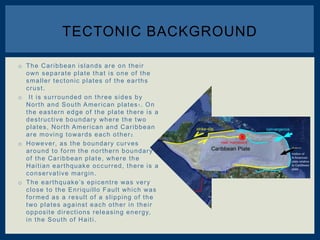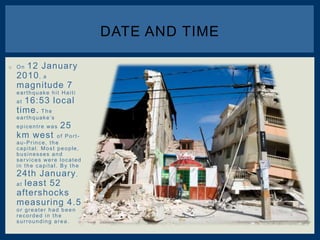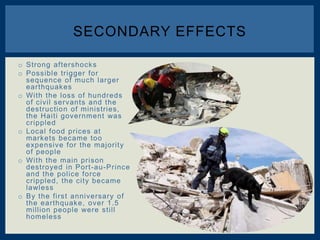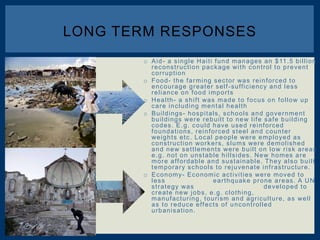Haiti earthquake case study
- 2. o Haiti is part of Hispaniola, a large Caribbean island of which the Dominican Republic takes up half of, East of Haiti. o It lies on the conservative plate margin between the Caribbean and North American tectonic plates. o A movement at this margin due to a large build up of pressure occurred at 16:53 local time on the 12th of January 2010, resulting in a devastating release of seismic activity at a magnitude of 7 on the Richter scale. o It was particularly devastating as the earthquakes epicentre was only 25km west of Port-au-Prince, Haiti’s capital city, in which most of the nations population, businesses and services are located. LOCATION
- 3. o The Caribbean islands are on their own separate plate that is one of the smaller tectonic plates of the earths crust. o It is surrounded on three sides by North and South American plates1 . On the eastern edge of the plate there is a destructive boundary where the two plates, North American and Caribbean are moving towards each other2 . o However, as the boundary curves around to form the northern boundary of the Caribbean plate, where the Haitian earthquake occurred, there is a conservative margin. o The earthquake’s epicentre was very close to the Enriquillo Fault which was formed as a result of a slipping of the two plates against each other in their opposite directions releasing energy, in the South of Haiti. TECTONIC BACKGROUND
- 4. o On 12 January 2010, a magnitude 7 earthquake hit Haiti at 16:53 local time. The earthquake’s epicentre was 25 km west of Port- au-Prince, the capital. Most people, businesses and services were located in the capital. By the 24th January, at least 52 aftershocks measuring 4.5 or greater had been recorded in the surrounding area. DATE AND TIME
- 5. PRIMARY EFFECTS o Many lives were lost, with many people killed by collapsing buildings o Port-au-Prince was flattened in less than 60 seconds o Lateral spreading resulted in the ground slumping or falling away o 50% of buildings collapsed, o Liquefaction on looser sediments caused building foundations to collapse o Infrastructure was brought down o 1.5 million people became homeless o Damage was localised– e.g. buildings built on hard bedrock near the epicentre suffered less damage o A small localised tsunami killed 7 people o The landscape was
- 6. o Strong aftershocks o Possible trigger for sequence of much larger earthquakes o With the loss of hundreds of civil servants and the destruction of ministries, the Haiti government was crippled o Local food prices at markets became too expensive for the majority of people o With the main prison destroyed in Port-au-Prince and the police force crippled, the city became lawless o By the first anniversary of the earthquake, over 1.5 million people were still homeless SECONDARY EFFECTS
- 7. o Immediate aid- $100 million in aid given by the USA and $330 million by the EU. However there was a lack of immediate aid. o Rescue efforts- international search teams struggled to recover people. They employed local people by the UNDP (United Nations Development Project) o Security- UN troops and police restored law and order o Food- the UN world food programme provided basic food necessities and farmers were given immediate support in order to help with the spring growing season o Water- bottled water and purification tablets were distributed o Health- emergency services were established to help prevent disease and perform lifesaving operations. o Shelter- Many people took advantage of 115,000 tents and 1,000,000+ tarpaulins that were provided. o Buildings- rapid structural assessments were made of buildings IMMEDIATE RESPONSES
- 8. o Aid- a single Haiti fund manages an $11.5 billion reconstruction package with control to prevent corruption o Food- the farming sector was reinforced to encourage greater self-sufficiency and less reliance on food imports o Health- a shift was made to focus on follow up care including mental health o Buildings- hospitals, schools and government buildings were rebuilt to new life safe building codes. E.g. could have used reinforced foundations, reinforced steel and counter weights etc. Local people were employed as construction workers, slums were demolished and new settlements were built on low risk areas e.g. not on unstable hillsides. New homes are more affordable and sustainable. They also built temporary schools to rejuvenate infrastructure. o Economy- Economic activities were moved to less earthquake prone areas. A UN strategy was developed to create new jobs, e.g. clothing, manufacturing, tourism and agriculture, as well as to reduce effects of uncontrolled urbanisation. LONG TERM RESPONSES
- 9. o The number of people in relief camps of tents and tarps since the quake was 1.6 million, and almost no transitional housing had been built. Most of the camps had no electricity, running water, or sewage disposal, and the tents were beginning to fall apart o 1 year after the earthquake, 1 million people were still without housing so had to continue to live in aid camps. o 6 months after the quake, 98% of the rubble/debris still hadn’t been cleared o Between 23 major charities, £1.1 billion had been collected for relief efforts in Haiti, but only two percent of the money had been released. o Significantly exacerbating the problem, a cholera outbreak occurred in Haiti in October 2010. LONG TERM IMPACTS
- 10. o The main reason why the Haiti earthquake was so devastating was due to its lack of preparation for the earthquake. o There was no education about earthquakes. o The buildings were not earthquake-safe buildings o There was also no stockpiling of emergency supplies o These are all because Haiti is an LEDC. After the quake struck, they were almost totally reliant upon the international community for aid relief. PREPARATION FOR THE EVENT
Editor's Notes
- both of which are very large and moving west of the Caribbean at around 2-3cm per year. with the more dense North American plate subducting below the Caribbean creating volcanic activity through the build up of pressure and for example on Montserrat. where the two same plates move alongside each other in opposite directions creating a build-up of pressure due top the extreme friction creating faults in the rock along the margin but also further inside the plate interior, from which the Haitian earthquake was triggered from most likely as









